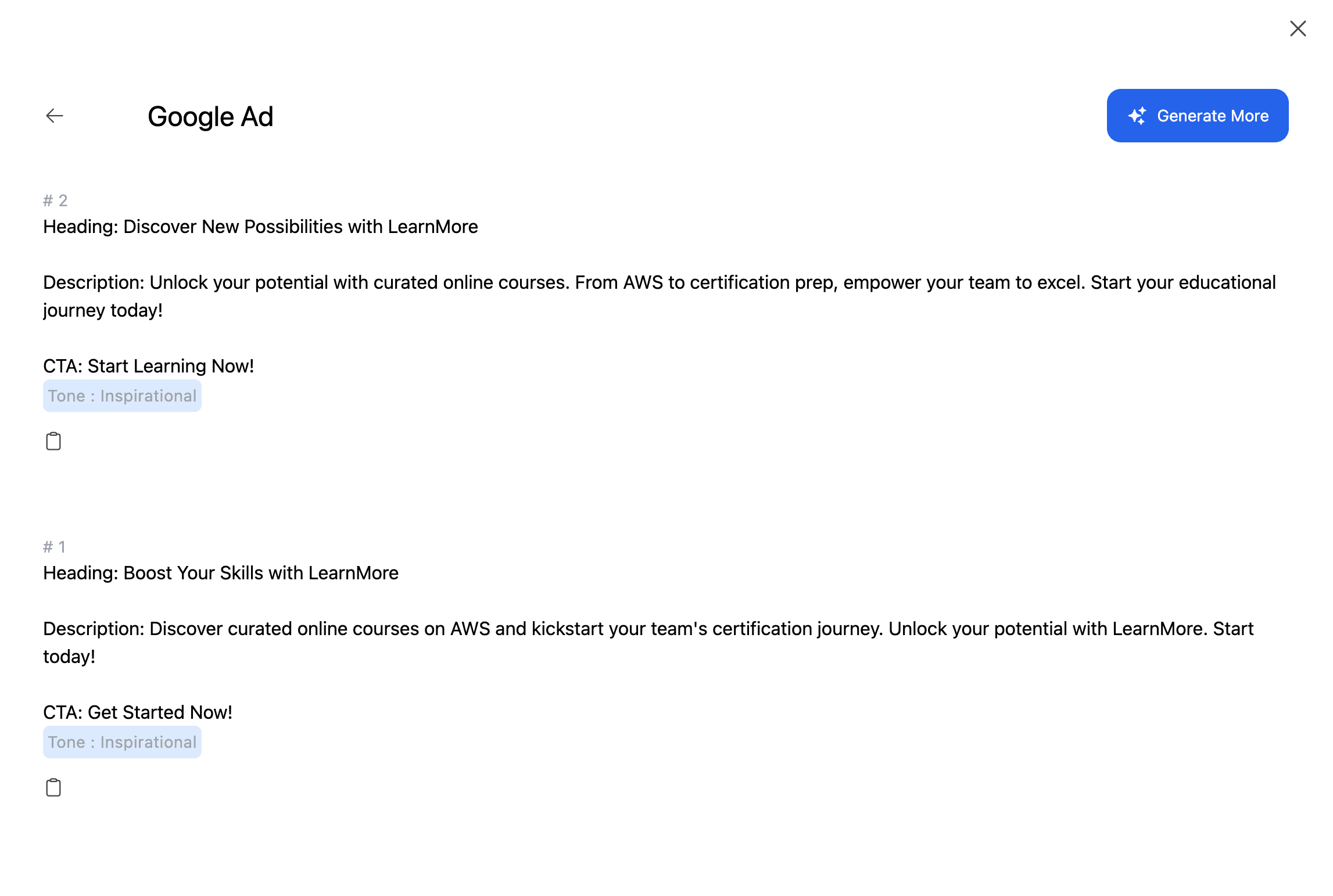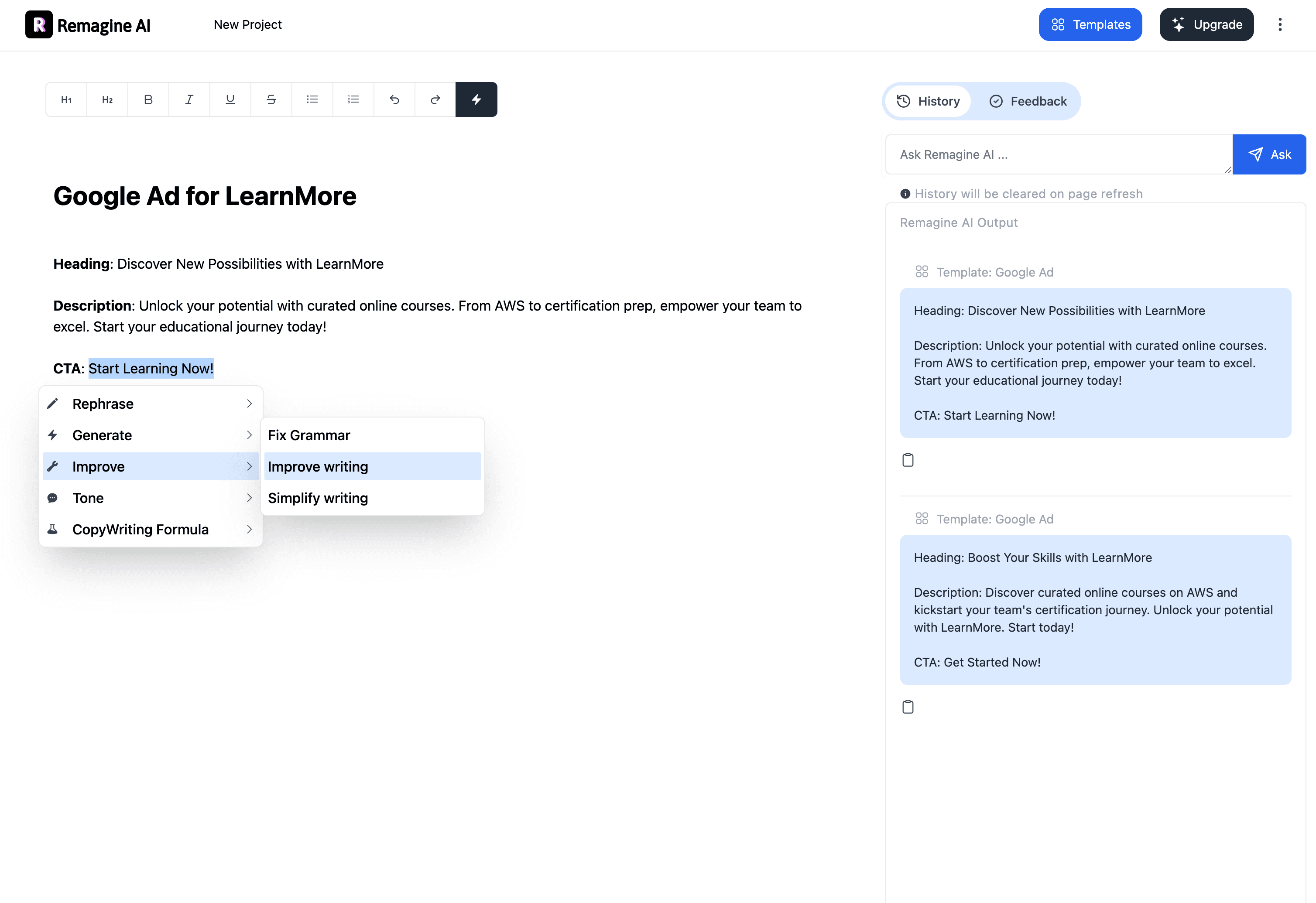AI powered Google Ads Generator
Elevate brand visibility and awareness through compelling, highquality Ads via Google Ads Generator instantly
Tone:
Trusted by people at world's best companies







Keyword Suggestions and Research
: Need help with keywords? Our tool provides suggestions and research to help you find the best keywords for your ads, boosting their effectiveness.

Targets Specific Audience
: Targeting your audience made easy! Our tool enables you to narrow down and focus on specific audiences, ensuring your ads reach the right people.

Multiple Options for Better Conversion
: Get more choices for higher conversion rates! We offer multiple ad options to optimize your campaigns, increasing the likelihood of better conversions.

Steps to use Google Ads Generator
#1 Fill in Business Details and Keywords
#2 Select Tone
#3 Include Additional Context and Points
#4 Generate Your Google Ads
#5 Make necessary iterations if required.
: Start by providing essential information like your Business Name, Business Description, and Keywords in the designated input fields. This helps the AI understand your business and target keywords.
Using the Google Ads Generator
Main components of a Google ad
Headline
The headline is arguably the most critical component of a Google ad. It serves as the first point of contact with potential customers, appearing prominently at the top of the ad. The character limit for the headline is typically 30 characters. It's essential to craft a compelling and concise headline that instantly communicates the core message of the ad.Description
The description follows the headline and provides additional information about the product or service being promoted. With a character limit of up to 90 characters, the description offers an opportunity to elaborate on key features, benefits, or any special offers. It should be crafted to entice users to take action, whether that's making a purchase, signing up, or learning more.Display URL
The display URL is the web address that is visible in the ad. While it doesn't necessarily have to match the actual landing page URL, it should accurately represent the destination where users will be directed upon clicking the ad. The display URL has a character limit, typically 15 characters for each part (path) and up to 15 characters for the domainInclude a proper Call to Action
Eg Shop now, Place your order, Book now, Buy today, Learn more, Call us now, Sign upHow does Google Ads work?
Effective ways of writing Google Ads
Being Specific:
Specify your product or service clearly in your ad. Avoid vague language and provide details that make your offering stand out. Specificity helps potential customers understand exactly what you're offering, increasing the likelihood of attracting the right audience.Being Direct:
Get straight to the point. Be concise and direct in your messaging. Users often skim through search results, so a direct and clear message is more likely to capture their attention. Highlight the most important information to quickly convey the value of your product or service.Including Keywords:
Incorporate relevant keywords that align with your business and target audience. Strategic use of keywords improves the chances of your ad appearing in relevant searches. Ensure that your ad copy is closely related to the keywords you are bidding on to enhance ad relevance.Being Proper:
Maintain professionalism in your ad copy by using proper grammar, spelling, and formatting. A well-crafted ad reflects positively on your brand and instills confidence in potential customers. Errors can detract from the credibility of your business, so proofread your ad before publishing to ensure accuracy and clarity.What is Google Ad?
How long can a Google ad copy be?
Track Google Ads performance
Do’s and Don’ts of Google Ads
Do's
Keyword Research:
Conduct thorough keyword research to target the most relevant and high-performing keywords for your business.A/B Testing:
Experiment with different ad variations to identify what resonates best with your audience.Landing Page Optimization:
Ensure that your landing pages align with ad content and are optimized for conversions.Regular Monitoring:
Keep a close eye on performance metrics and adjust bids and targeting accordingly.Don'ts
Keyword Stuffing:
Avoid overloading your ad copy with keywords; focus on natural and relevant language.Ignoring Negative Keywords:
Neglecting negative keywords can lead to irrelevant clicks; regularly update your negative keyword list.Ignoring Quality Score:
A low-quality score can impact ad placement and costs; prioritize improving ad relevance and landing page experience.Neglecting Mobile Optimization:
With a growing number of users on mobile devices, ensure your ads and landing pages are optimized for mobile viewing.FAQ
Answers to the most frequently asked questions.
Write at the Speed of Light
No Credit Card required